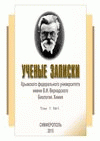Institut biologii vnutrennih vod im. I. D. Papanina Rossiyskoy akademii nauk
Swamps are unique natural systems with undeniable biosphere importance. The development of swamp ecosystems is accompanied by a change in their phytocenotic structure. These transformations lead to changes in the characteristics and properties of peat deposits. The study of the above-mentioned phenomenon allows us to trace the history of the development of swamps and determine the features of their formation at various stages of functioning. The properties of a peat deposit vary significantly from the type of swamp and often change under the influence of various physical and geographical factors. The purpose of the study is to classify, characterize some properties and determine the species saturation of the peat deposit of the lowland valley swamp Ishtan. Research based on the results of studying its botanical composition. We performed sample preparation and analyzed the botanical composition of peat, the degree of decomposition of plant residues, and the level of mineral contamination of all 3 wells (120 samples). For the methodological basis of the classification of the peats we used the classification proposed in 1976 by the peat scientist S. N. Tyuremnov. According to it, the name of peat includes only those peat-forming agents, the proportion of which is at least 20 %. The peat deposit of the Ishtan swamp belongs to the lowland type. The variety of plant components in peat allows it to be attributed to complex multilayer peats of forest (14 samples, 11.67 %), forest-swamp (63 samples, 52.5 %) and swamp subtype (43 samples, 35.83 %), where the predominance of Cyperaceae, Menyanthes trifoliata, wood, Hypnales peat and their combinations is noted at various depths. The following groups are most represented: herbal-wood (26 samples), wood (23), herbal (22), wood-herbal (21). These 4 groups account for over 76 % of all peat groups represented. The two following groups are noted less frequently: herbal-moss (10) and moss-herbal (9). The remaining groups occur singly, their role in peat composition is insignificant. We have identified 27 types of peat. The most common species is the woody coniferous (Pinus sylvestris + Picea obovata) ((27 samples/22.5 %). Further in distribution: Menyanthes trifoliata-woody (14/11.67 %), Cyperaceae (11/9.17 %), Menyanthes trifoliata-Cyperaceae (8/6.67 %), Cyperaceae-Hypnales lowland (7/5.83 %). The average number of peat-forming species is 7.71/per sample. The highest average value was determined for the Menyanthes trifoliata-Cyperaceae-Hypnales type of peat (14). The peat deposit of the Ishtan swamp is composed of at least 48 species of plants. The main peat-forming agents of lowland valley swamps are the following plants and their groupings: I. Woody: I-a. Conifers (Picea obovata + Pinus sylvestris). The occurrence in peat (C) is 88.33 %, the highest average proportion (avg.) is 38.27 %, the maximum values of the proportion in peat composition (max) reach 95 %. I-b. Deciduous (Various Betula sp. with a small proportion of other deciduous trees and shrubs). B – 35 %, avg. – 14.37 %. Often, such peat is an admixture to the remains of conifers. They are also indicators of a change in trophic conditions towards depletion in rare cases. II. Herbal: II-a. Carex cespitosa. It occurs in 25 % of samples with an average fraction of 5.17 %. II-b. Carex lasiocarpa. The most important peat-forming agent. The occurrence is 89.17 %, the average proportion is 23.77 %, max is 95 %. Often, independently or with the other sedges creates layers of pure sedge peat. II-c. Carex omskiana. B – 11.67 %, avg. – 12.21 %, max – 40 %. II-d. Carex rostrata. B – 21.67 %, avg. – 3.35 %, max – 15 %. II-e. Equisetum palustre. B – 35 %, avg. – 5.81 %, max – 25 %. It is often marked by a small impurity from 1 to 10 %. It forms woody-Equisetum—Menyanthes trifoliata and Equisetum—Menyanthes trifoliata peat layers unique for the territory. II-f. Menyanthes trifoliata. The most common species in the peat deposits of the Ishtan swamp. It is found in 94.17 % of peat samples with an average fraction of 20.03 % and a max of 80 %. It forms both pure shift peat and its combinations with woody, herbal and moss species. III. Mosses (Bryum spp., Calliergon spp., Drepanocladus spp., Meesia spp., Mniaceae spp., Warnstorfia spp.) Remains of mosses were noted in 75.83 % of samples with an average fraction of 14.53 %. Due to the high degree of decomposition, residues can often be determined only up to the genus. The average degree of peat decomposition of the Ishtan swamp is 40.47 %. The highest average values (50 %) were determined for woody-Menyanthes trifoliata-Cyperaceae, woody-Equisetum-Menyanthes trifoliata, Equisetum-Menyanthes trifoliata and Menyanthes trifoliata-Cyperaceae peat, and the lowest average (25 %) – for woody-Cyperaceae-Hypnales species. The latter is due to its occurrence at a minimum depth of 0–10 cm. The maximum degree of decomposition (60 %) is noted for coniferous and Menyanthes trifoliata-Cyperaceae peat. Both samples lie at maximum depths and border on the mineral gley horizon underlying the peat deposit. We noted 61 directions of transitions of peat species, of which only 6 were repeated two or more times. The prospects for further exploration of the peat deposits of the territory are determined by two equally important directions. The first of them is the qualitative improvement of the knowledge base about the studied object – the physico-chemical properties of peat can be established in addition. The second direction is the expansion of the geography of research (for example, the study of more southern segments of the Ob swamp). The last step may be the generalization of knowledge and the identification of global patterns of development and functioning of the marshes of the territory on the basis of the obtained data array.
lowland swamp, peat deposit, species saturation, peat formation, degree of peat decomposition.
1. Savichev O. G. Guseva N. V., Kuprijanov E. A. [et al.] Himicheskij sostav vod Obskogo bolota (Zapadnaja Sibir') i ego prostranstvennye izmenenija pod vlijaniem sbrosov zagrjaznjajushhih veshhestv,
2. Lapshina E. D. Bogs in the southeast of West Siberia: Botanical diversity, development history and accumulation dynamics of carbon in the Holocene, Doctoral (Biol.) Dissertation, 512 (Tomsk: TGU,
3. Landshaftnaya karta SSSR masshtaba 1:2500000, izdannaya na 16 listax, Otv. red.: I. S. Gudilin, (M.: Ministerstvo geologii SSSR, 1980).
4. Liss O. L., Abramova L. I., Avetov N. A. [et al.]. Bog Systems of Western Siberia and Their Significance for Nature Conservation, 584 (Tula : Grif i Ko, 2001).
5. L’vov Yu. A. Bolotnye resursy, Prirodnye resursy Tomskoi oblasti, 67 (Novosibirsk: Nauka, Sibirskoe otdelenie, 1991).
6. Baisheva E. Z., Muldashev A. A., Martynenko V. B. [et al.] Plant diversity and spatial vegetation structure of the calcareous spring fen in the “Arkaulovskoye Mire” Protected Area (Southern Urals,
7. Sinyutkina A. A. Estimation of the raised bogs peat deposit transformation of West Siberia south-eastern part, Geosphere Research, 1, 78 (2020).– DOIhttps://doi.org/10.17223/25421379/14/6. EDN: https://elibrary.ru/FNSOXE
8. Logvinova L. A., Zykova M. V., Krivoshchekov S. V., Drygunova L. A., Perederina I. A., Golubina O. A., Perminova I. V., Konstantinov A. I., Belousov M. V. Khimiya Rastitel'nogo Syr'ya, 1, 277 (2022). DOI: https://doi.org/10.14258/jcprm.20220110663; EDN: https://elibrary.ru/DVYGXM
9. Maslov S. G., Inisheva L. I., Porokhina E. V. Khimiya Rastitel'nogo Syr'ya, 2, 311 (2023) (in Russ.). DOI:https://doi.org/10.14258/jcprm.20230211764. EDN: https://elibrary.ru/ZISOIG
10. Razjigaeva N. G., Grebennikova T. A., Ganzey L. A. [et al.] The stratigraphy of the blanket peatland and the development of environments on Bolshoi Shantar Island in the Late Glacial–Holocene, Russian
11. Kutenkov S., Chakov V., Kuptsova V. Topology, vegetation and stratigraphy of far eastern Aapa mires (Khabarovsk region, Russia), Land, 11, 1, 96. (2022). DOI: https://doi.org/10.3390/land11010096; EDN: https://elibrary.ru/NFMAZH
12. Vincze I., Magyari E., Braun M. [et al.] Paleoclimate reconstruction and mire development in the Eastern Great Hungarian Plain for the last 20,000 years, Review of Palaeobotany and Palynology, 271, 104112.
13. Kalnina L., Kuske E., Ilze Ozola Peat stratigraphy and changes in peat formation during the Holocene in Latvia, Quaternary International, 383, 186 (2015).
14. Avetov N. A., Kuznetsov O. L., Shishkonakova E. A. Soils f Oligomesotrophic nd Mesotrophic Bogs in the Boreal Zone of West Siberia: Possibilities of Botanical Diagnostics within the Framework of the Type
15. Avetov N. A., Kuznetsov O. L., Shishkonakova E. A. Experience in the use of Russian soil classification and diagnosis in the systematics of peat soils of oligotrophic bogs in the north taiga subzone of West
16. Shishkonakova E. A., Avetov N. A., Vindeker G. V., Tolpysheva T. Yu., Garaeva N. R. Soil- and biodiversity of the former peat mines in Shaturskaya Meshchera in the context of their
17. Bariczkaya V. A., Chepinoga V. V. Geobotanika i metody` geobotanicheskix issledovanij, 193 (Irkutsk : Irkutskij gosudarstvenny`j universitet, 2014).
18. Suvorov V. V., Voronova I. N. Botanika s osnovami geobotaniki : uchebnik dlya podgotovki bakalavrov, obuchayushhixsya po napravleniyam 110400 "Agronomiya" i 110500 "Sadovodstvo", 3-e izdanie,
19. Schuryakov D. S. The results of study of botanical composition of peat deposit of the Ishtan swamp massif, Botanika i botaniki v menyayushhemsya mire: trudy` Mezhdunarodnoj nauchnoj
20. Dombrovskaya A. V., Koreneva M. M., Tyuremnov S. N. Atlas rastitel`ny`x ostatkov, vstrechaemy`x v torfe, 137 (–L. : Gosenergoizdat, 1959).
21. Kats N. Ya., Kats S. V., Skobeyeva Ye. I. Atlas rastitel'nykh ostatkov v torfakh, 371 (M. : Nedra, 1977).
22. Tyuremnov S. N. Torfyanyye mestorozhdeniya, 488 (M.: Nedra Publ., 1976).





